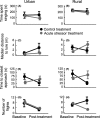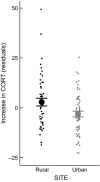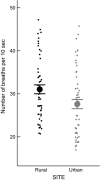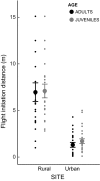Effect of acute stressor on reproductive behavior differs between urban and rural birds
- PMID: 27777728
- PMCID: PMC5058526
- DOI: 10.1002/ece3.2347
Effect of acute stressor on reproductive behavior differs between urban and rural birds
Abstract
The life-history trade-off between self-maintenance and reproduction posits that investment in one function decreases investment in the other. Manipulating the costs and benefits of functions involved in a trade-off may alter this interaction. Here we ask whether investment in self-maintenance during a stress response alters territorial behavior in wild Dark-eyed Juncos and whether rural and urban birds, which are known to differ in the magnitude of the stress response (greater in rural), also differ in the degree to which stress reduces territorial behavior. In rural and urban habitats, we measured territorial behavior using song playback, followed by either an acute stressor (capture and collection of a blood sample) or a nonstressful control situation. The following day, we again measured territorial behavior, predicting greater reduction in territorial behavior in individuals exposed to the stressor but a lesser reduction in territorial behavior in the urban as compared to the rural environment. We further assessed individual and population differences in response to stressors by measuring flight initiation distance, breath rate, and corticosterone levels in the blood. The rural population had a higher physiological and behavioral stress response than the urban population, and acute capture stress had a lasting (24 h) negative effect on territorial behavior, but only in the rural habitat. However, individual-level differences in measures of the stress response did not explain variation in the impact of stress on territorial behavior. Our findings show that stressors can have a negative effect on territorial behavior, but that this effect may differ between populations that vary in their stress ecology.
Keywords: Aggression; behavioral plasticity; flexibility; global change; reproduction; stress.
Figures





Similar articles
-
Territorial aggression in urban and rural Song Sparrows is correlated with corticosterone, but not testosterone.Horm Behav. 2018 Feb;98:8-15. doi: 10.1016/j.yhbeh.2017.11.010. Epub 2017 Dec 22. Horm Behav. 2018. PMID: 29166572
-
What About Females? Urban Female Song Sparrows Elevate Aggressive Signaling Compared to Rural.Integr Comp Biol. 2022 Jul 5:icac106. doi: 10.1093/icb/icac106. Online ahead of print. Integr Comp Biol. 2022. PMID: 35790130
-
Regulation of plasma testosterone, corticosterone, and metabolites in response to stress, reproductive stage, and social challenges in a desert male songbird.Gen Comp Endocrinol. 2014 Jul 1;203:120-31. doi: 10.1016/j.ygcen.2014.01.010. Epub 2014 Feb 8. Gen Comp Endocrinol. 2014. PMID: 24518569
-
A review of urban impacts on avian life-history evolution: Does city living lead to slower pace of life?Glob Chang Biol. 2018 Apr;24(4):1452-1469. doi: 10.1111/gcb.13969. Epub 2017 Nov 23. Glob Chang Biol. 2018. PMID: 29168281 Review.
-
Arctic spring: hormone-behavior interactions in a severe environment.Comp Biochem Physiol B Biochem Mol Biol. 2002 May;132(1):275-86. doi: 10.1016/s1096-4959(01)00540-1. Comp Biochem Physiol B Biochem Mol Biol. 2002. PMID: 11997229 Review.
Cited by
-
Beyond simple habituation: Anthropogenic habitats influence the escape behaviour of spur-winged lapwings in response to both human and non-human threats.J Anim Ecol. 2023 Feb;92(2):417-429. doi: 10.1111/1365-2656.13858. Epub 2022 Dec 15. J Anim Ecol. 2023. PMID: 36477653 Free PMC article.
-
Stress in the city: meta-analysis indicates no overall evidence for stress in urban vertebrates.Proc Biol Sci. 2020 Oct 14;287(1936):20201754. doi: 10.1098/rspb.2020.1754. Epub 2020 Oct 7. Proc Biol Sci. 2020. PMID: 33023414 Free PMC article.
-
Are behaviour and stress-related phenotypes in urban birds adaptive?J Anim Ecol. 2022 Aug;91(8):1627-1641. doi: 10.1111/1365-2656.13740. Epub 2022 Jun 1. J Anim Ecol. 2022. PMID: 35575101 Free PMC article.
-
The effect of chronic and acute stressors, and their interaction, on testes function: an experimental test during testicular recrudescence.J Exp Biol. 2018 Sep 10;221(Pt 17):jeb180869. doi: 10.1242/jeb.180869. J Exp Biol. 2018. PMID: 29997161 Free PMC article.
-
The impact of urbanization on health depends on the health metric, life stage and level of urbanization: a global meta-analysis on avian species.Proc Biol Sci. 2024 Aug;291(2027):20240617. doi: 10.1098/rspb.2024.0617. Epub 2024 Jul 17. Proc Biol Sci. 2024. PMID: 39016598 Free PMC article.
References
-
- Akçay, Ç. , Clay A., Campbell S. E., and Beecher M. D.. 2016. The sparrow and the hawk: aggressive signaling under risk of predation. Behav. Ecol. 27:601–607.
-
- Atwell, J. W. , Cardoso G. C., Whittaker D. J., Price T. D., and Ketterson E. D.. 2014. Hormonal, behavioral, and life‐history traits exhibit correlated shifts in relation to population establishment in a novel environment. Am. Nat. 184:E147–E160. - PubMed
-
- Bell, A. M. , and Sih A.. 2007. Exposure to predation generates personality in threespined sticklebacks (Gasterosteus aculeatus). Ecol. Lett. 10:828–834. - PubMed
Grants and funding
LinkOut - more resources
Full Text Sources
Other Literature Sources

